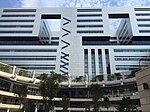Bank of Ideas
2011 establishments in the United Kingdom2011 in London2012 disestablishments in the United KingdomEvicted squatsInfoshops ... and 4 more
Occupy movement in the United KingdomProtests in LondonSocial centres in the United KingdomSquats in the United Kingdom

The Bank of Ideas was a squatted, self-managed social centre in a disused UBS office complex on Sun Street in the City of London, England. It remained in the building from November 2011 until January 2012. The building was owned by UBS, and the squatters were members of the Occupy London protest movement. The building was described by an Occupy London spokesman as "a space for political discussion".
Excerpt from the Wikipedia article Bank of Ideas (License: CC BY-SA 3.0, Authors, Images).Bank of Ideas
Sun Street, City of London
Geographical coordinates (GPS) Address Nearby Places Show on map
Geographical coordinates (GPS)
| Latitude | Longitude |
|---|---|
| N 51.520213 ° | E -0.084382 ° |
Address
UBS
Sun Street
EC2M 2PL City of London
England, United Kingdom
Open on Google Maps










